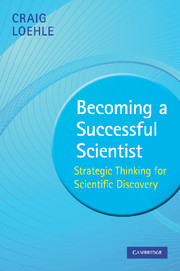5 - Summary: the strategic approach to science
Published online by Cambridge University Press: 05 June 2012
Summary
Science as a career is fascinating and fulfilling. The popular picture of what scientists do, however, does not provide a useful guide to those considering a science career. The first section of this book provided an overview of science as a profession and what scientists do. The central focus of the book, however, is on the inner game of science. How do scientists solve problems and discover new things? How can they increase productivity? What techniques can they use? To address this issue, a strategic problem solving approach is proposed.
Strategic thinking is an overall technology for problem solving with the potential for increasing both the quantity and quality of work in fields where creation of novel solutions is critical, such as design, invention, institutional innovation, research, software development, and engineering. It is based on an understanding of both outward processes (actions) and inner operations (cognition, attitudes). It takes particular care to be alert to the inherent flaws in all aspects of the problem solving process, and builds in checks and balances against these flaws.
There are four factors involved in the successful development of an innovative creation: creative mental functioning, an understanding of the discovery process, an appreciation of the structure of multistep problems, and the utilization of reality checks. Creative mental functioning is necessary to be able to recognize problems, overcome intimidation by the status quo, overcome barriers to thought, and avoid stagnation.
- Type
- Chapter
- Information
- Becoming a Successful ScientistStrategic Thinking for Scientific Discovery, pp. 238 - 244Publisher: Cambridge University PressPrint publication year: 2009



